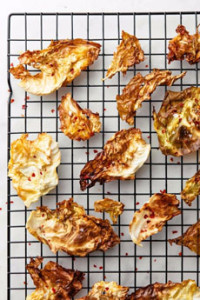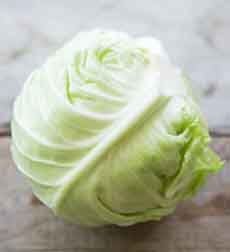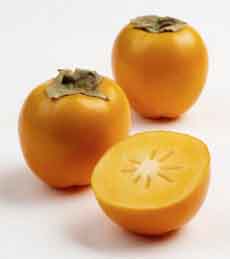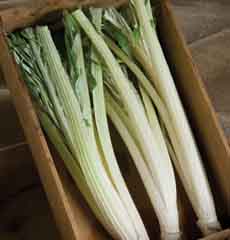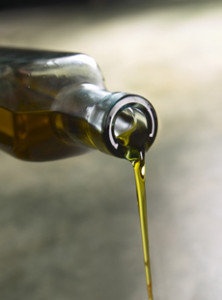|
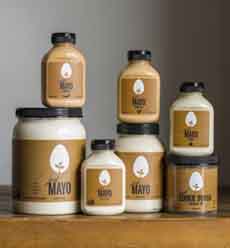

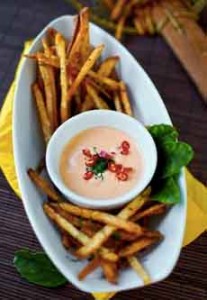
Top photo: the Just Mayo line. Second photo: Crab cake with Chipotle Just Mayo. Third photo: Sriracha Just Mayo with fries. Photos courtesy Just Mayo. Bottom photo: Grilled Mexican corn (elote) with Original Just Mayo. Photos courtesy Hampton Creek.
|
|
The Just Mayo line from Hampton Creek has been getting a lot of attention since its debut in 2013.
The San Francisco start-up focuses on foods with plant-based egg alternatives. Its first two products are Just Mayo and Just Cookie Dough, with Just Dressing, Just Pancake Mix and an eggless, plant-based scramble on the horizon.
The full-fat mayonnaise alternative is made from expeller-pressed canola oil so for starters, they’re cholesterol free, allergy friendly and more sustainable (no animals to pollute the environment). The ingredients are non-GMO.
The line is vegan, but you won’t find that designation promoted on the current product label. Rather, it’s marketed as healthier, better tasting and more sustainable for the planet.
The brand did such a good job of attracting attention that Unilever, the parent company of mayo megabrand Hellmann’s, filed a lawsuit against Hampton Creek in 2014, since government specifications dictate that mayonnaise is made with eggs. The FDA was tipped off, as well.
Last month, it was reported that the issues have been resolved, by changing the product label. The new label describes the product as egg-free and non-GMO, and explains that “Just” in the product name means means “guided by reason, justice and fairness.” The brand will not claim to be cholesterol-free or heart-healthy. Here’s a report of the FDA’s decision.
The new label is not yet out, but we’re guessing the image of a whole egg will be removed, too.
JUST MAYO’S FOUR FLAVORS
Just Mayo is made in four flavors: Original, Chipotle, Garlic and Sriracha. The flavored varieties especially add zing.
So what are the ingredients?
Canola oil, water, white vinegar and 2% or less of organic sugar, salt, pea protein, spices, modified food starch, lemon juice concentrate, fruit and vegetable juice for color) and calcium disodium EDTA to preserve freshness.
If you have a sharp eye you’ve noticed the substitution: pea protein, a relatively new ingredient that is used as an alternative to whey protein in cheeses and yogurt. Made from a specific variety of the Canadian yellow pea, it has a neutral taste.
And speaking of taste: In our blind taste test, about half of the testers preferred Original Just Mayo to Hellmann’s Real Mayonnaise.
USES
Just Mayo can be used as a substitute for mayonnaise anywhere. For example:
Burgers and sandwiches
Dips
Mayonnaise-bound salads: carrot salad, cole slaw, egg salad, pasta salad, potato salad, tuna and seafood salads, etc.
Salad dressing for green salads
Sauces and plate garnishes
Anywhere you use mayonnaise (check the website for basic recipes: cole slaw, potato salad, salad dressings and other favorites)
|
A FEEL GOOD PRODUCT
In addition to the environmental benefit (no animal pollution), we feel better about egg-free products. Much as we love eggs, most sold in the U.S. are laid by hens raised in cruel conditions. About 88% are housed in tiny battery cages.
Just Mayo is available at grocery stores nationwide, including Costco, Safeway, Walmart and Whole Foods Market. You can also use the website store locator. The product is available in 8 ounce (SRP $3.99) and 16 ounce (SRP $4.49) bottles.
AT THE END OF THE DAY…
While we enjoyed Just Mayo enough to make it a Top Pick, we’ll stick with our personal favorite (and eggy) mayonnaise, Lemonaise from The Ojai Cook (here’s our review).
We love the added nuance of a flavored mayonnaise, and Lemonaise is made in Original, Light, Cha Cha Chipotle, Fire And Spice (tomato, cayenne, cumin) Garlic Herb (basil and tarragon), Green Dragon (mustard, cilantro, wasabi) and Latin (chiles, lime, cumin).
|

